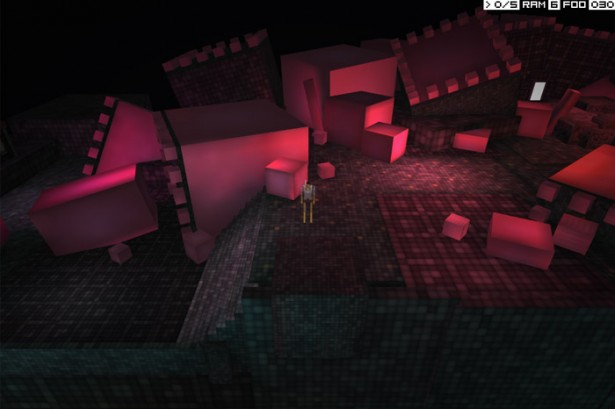 A couple months ago, I wrote a post in which I began thinking through some of the implications Laura Mulvey’s theory of the male gaze might have for the ways we think about video games—that is, how it is the gaze might impact the ways we play. I’ve been thinking through such things because I’ve been wondering how it is the gaze manifests itself in the ways we interact with a variety of media forms, whether it is film (as Laura Mulvey conceives of it) or video games. To be sure, whether it is film or games, the gaze, in both cases, is mediated by the screen—by an interface. And when considering the implications of the interface as a space of mediation, or, perhaps we might say, as a medium, I have come to wonder—what is the role of the gaze for the player? How does the interface affect the ways we gaze when we play? And do certain modes of gazing come to be privileged by the video game interface and the gaming community?
A couple months ago, I wrote a post in which I began thinking through some of the implications Laura Mulvey’s theory of the male gaze might have for the ways we think about video games—that is, how it is the gaze might impact the ways we play. I’ve been thinking through such things because I’ve been wondering how it is the gaze manifests itself in the ways we interact with a variety of media forms, whether it is film (as Laura Mulvey conceives of it) or video games. To be sure, whether it is film or games, the gaze, in both cases, is mediated by the screen—by an interface. And when considering the implications of the interface as a space of mediation, or, perhaps we might say, as a medium, I have come to wonder—what is the role of the gaze for the player? How does the interface affect the ways we gaze when we play? And do certain modes of gazing come to be privileged by the video game interface and the gaming community?
When thinking further about the gaze, I’m reminded of John Berger’s Ways of Seeing, in which Berger argues that ideological structures impact the ways we see. He, too, makes similar claims to Mulvey’s regarding the male gaze, arguing that women are depicted differently from men because men are the presumed default—the ideal spectator. Yet, it also seems important to note that privileged spectatorship is configured not solely around issues of gender but around issues of race also, which is something that Martin Berger discusses in Sight Unseen: Whiteness and American Visual Culture. Indeed, Berger argues that such issues influence the interpretation of the visual world, and the visual world reifies such normative and racialized ideologies. And these internalized beliefs, manifested across the visual field, typically privilege the white male gaze.
 Yet, the gaze, of course, is not an ahistorical construct and is, thus, impacted by the historical context in which such privileged spectatorship is situated. Mulvey herself notes this in “The Pleasure Principle,” in which she points out that technological change has had a significant impact on the idea of spectatorship. And in “Looking at the Past from the Present: Rethinking Feminist Film Theory of the 1970s,” Mulvey continues this line of thinking regarding technological change, arguing that not only have new technologies “given new life” to our understanding of cinema, but so too have the ways we have complicated our understanding of spectatorship and the gaze. Indeed, Mulvey admits that there is potential for transgressing the male gaze, and such transgressive spectatorship is something that Gilad Padva and Nurit Buchweitz expand on, for they argue that Mulvey’s theorization of the male gaze has since been problematized by theorists who have contended that transgressive spectatorship can work to subvert and blur the boundaries between viewer and viewed, seer and seen, and the manner in which these boundaries become configured based on gender, race, and sexuality.
Yet, the gaze, of course, is not an ahistorical construct and is, thus, impacted by the historical context in which such privileged spectatorship is situated. Mulvey herself notes this in “The Pleasure Principle,” in which she points out that technological change has had a significant impact on the idea of spectatorship. And in “Looking at the Past from the Present: Rethinking Feminist Film Theory of the 1970s,” Mulvey continues this line of thinking regarding technological change, arguing that not only have new technologies “given new life” to our understanding of cinema, but so too have the ways we have complicated our understanding of spectatorship and the gaze. Indeed, Mulvey admits that there is potential for transgressing the male gaze, and such transgressive spectatorship is something that Gilad Padva and Nurit Buchweitz expand on, for they argue that Mulvey’s theorization of the male gaze has since been problematized by theorists who have contended that transgressive spectatorship can work to subvert and blur the boundaries between viewer and viewed, seer and seen, and the manner in which these boundaries become configured based on gender, race, and sexuality.
Perhaps the concept of the interface is one that can allow us to situate the conversation regarding the gaze—this conversation regarding the manner in which the gaze is complicated by the emergence of new (transgressive) forms of spectatorship and new technologies—within the context of video games and gaming culture. As Alexander Galloway argues in The Interface Effect, new technologies and new media rely on open interfaces, which results in what he calls “the interface effect,” in which the computer, then, is not a static object but an active process of mediation. The computer, then, is liminal, a mediating structure, an interactive system, but this system is one that Johanna Drucker argues also disciplines and constrains, one that actively determines what we can do in digital environments—digital environments like those of video games.
 And when it comes to games, what we seem to be dealing with is a medium, a digital environment, that requires the male gaze in the ways we interact with gameworld interfaces. Such interactions result from the interfaces’ integration of a variety of components—the game’s narrative, its mechanics, its visuality, its gameworld, its perspective, its mode of play, and this integrated system of the gameworld interface seems emblematic of W.J.T. Mitchell’s argument that all media are mixed media (and, similarly, emblematic of Irena Rajewsky’s conception of intermediality). Such mixed media, such intermediality, then, means that visual culture isn’t just about images—it’s not just about what is seen—but about how we see them, about what influences the practices of seeing and the practices of showing, about what guides the ways we see and interpret what is on the screen. To be sure, the gaze is one such guide, and the interface is one too, and through the intersection of the two in the world of video games, certain gazes are privileged, certain modes of looking have more power than others, and often these gazes perpetuate the structures of gendered and raced power in which we are all embedded. And ultimately, the privileged gazes that are perpetuated within the gaming community reveal the manner in which we might come to understand the power of the gaze, the power of active looking through the interface.
And when it comes to games, what we seem to be dealing with is a medium, a digital environment, that requires the male gaze in the ways we interact with gameworld interfaces. Such interactions result from the interfaces’ integration of a variety of components—the game’s narrative, its mechanics, its visuality, its gameworld, its perspective, its mode of play, and this integrated system of the gameworld interface seems emblematic of W.J.T. Mitchell’s argument that all media are mixed media (and, similarly, emblematic of Irena Rajewsky’s conception of intermediality). Such mixed media, such intermediality, then, means that visual culture isn’t just about images—it’s not just about what is seen—but about how we see them, about what influences the practices of seeing and the practices of showing, about what guides the ways we see and interpret what is on the screen. To be sure, the gaze is one such guide, and the interface is one too, and through the intersection of the two in the world of video games, certain gazes are privileged, certain modes of looking have more power than others, and often these gazes perpetuate the structures of gendered and raced power in which we are all embedded. And ultimately, the privileged gazes that are perpetuated within the gaming community reveal the manner in which we might come to understand the power of the gaze, the power of active looking through the interface.
But why examine such things? What do we gain from the interrogation of gaze and interface in video games? What do we gain from problematizing the power of active looking through the interface? Such questions cause me to think about my own play and my own experiences with the gaze in video games. As a woman playing games, as a woman who does not fit the (as Anita Sarkeesian puts it) “presumed straight male player” mold, I have had to make use of my own transgressive spectatorship, my own transgressive play, my own form of critical play as a form of resistance. And perhaps both this idea of transgressive play as well as the critique of the gaze and the interface in games allow us to contextualize and challenge the violences that occur in games and to situate them within broader systems of power and oppression–because such violences are not unique to games. And in order to engage in such work, we need to interrogate how games and gaming culture requires and privileges certain modes of seeing—how it makes use of seers and the seen. Such an interrogation allows us, then, to imagine possibilities for change. And such change is needed for us to disrupt the manner in which gendered structures and hierarchical modes of looking (such as the male gaze) impact the ways we interact with the interface of video games.




